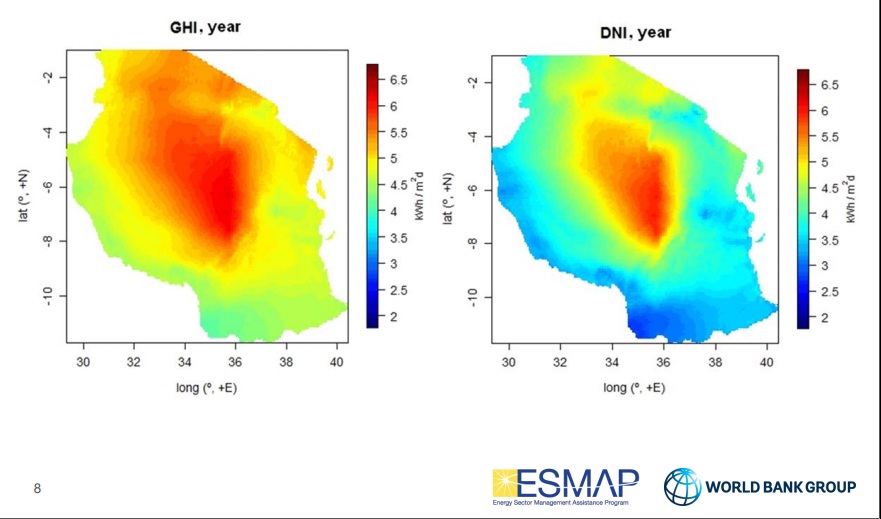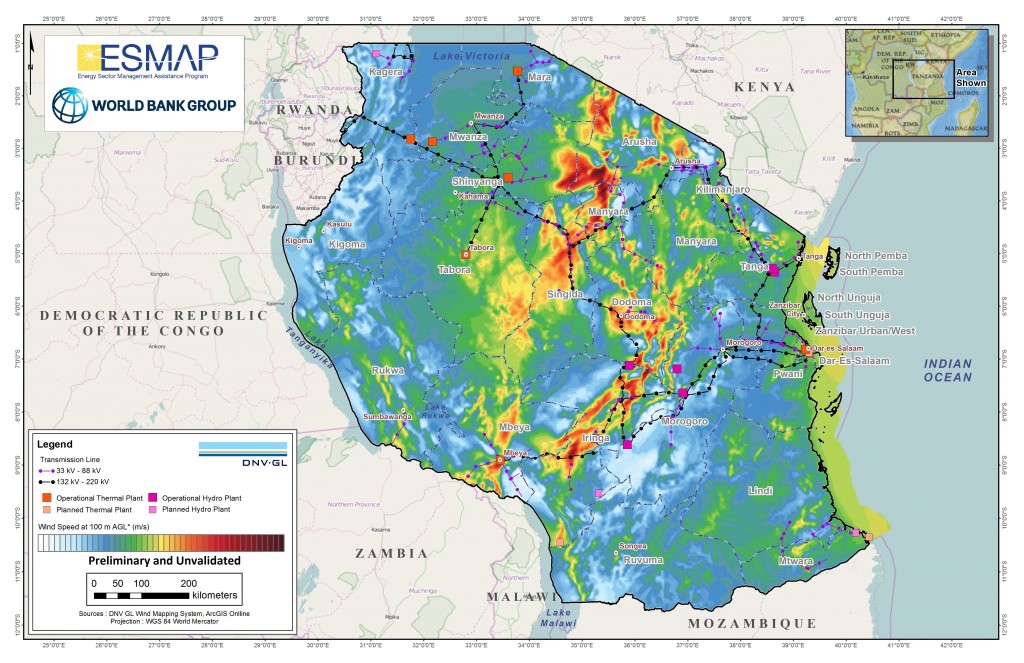Vast areas in Tanzania are potentially conducive for commercial production of electricity from solar, wind energy.

Preliminary Findings: Red areas potentially more suitable for harvesting solar energy. Blue areas less condusive.
By Jaston Binala.
Vast areas of land are conducive for setting up solar and wind ‘farms’ to harvest renewable energy in Tanzania but private sector investors are not showing sufficient interest despite liberalization of the country’s energy sector in 2008.
The state owned Tanzania Electricity Supply Company (TANESCO) no longer has monopoly on the production and distribution of electricity after the power sector liberalization in 2008, Eng. Felchesmi Mramba, the TANESCO Managing Director told reporters at a renewable energy press conference held at the World Bank offices in Dar es Salaam in late May.
An area the size of Malawi inside Tanzania is available to the private sector for production of electricity through wind energy, preliminary findings made by the World Bank funded Energy Sector Management Assistance Progamme (ESMAP) have determined.
Preliminary findings by ESMAP, determined by the study of satellite imagery and weather patterns using computer calculations, have shown that about 10.8% of Tanzania, equivalent to the size of Malawi, has sufficient wind energy for production of electricity, Oliver Knight, an ESMAP Senior Energy Specialist based in Washington DC told reporters at the press conference.
The private sector is free to invest in these areas for electricity production and distribution, Mramba said, but there is virtually no interest being shown so far– probably due to costs involved.
TANESCO welcomes private sector players in this field, he said, adding that the state company would be more than happy to buy any electricity produced by the private sector for re-sale since the company already has in place the distribution infrastructure.
Technological developments have made it cheaper to produce electricity from renewable energies now than it was the case in the past, Knight said.
The cost of producing electricity from wind, for instance, is currently below USD 15 cents per kilowatt hour, compared to hydro power which currently costs about USD 20 cents per kilowatt hour, or fuel oil which costs about USD 25 cents per kilowatt hour. The current electricity production cost by Solar PV is below USD 20 cents per kilowatt hours, a chart given to reporters by Knight shows.
But the private sector is not showing sufficient interest to invest in the energy sector since liberalization of the sector in 2008 according to the TANESCO CEO.
The ESMAP Senior Energy Specialist showed reporters a map indicating the regions of Iringa, Tabora, Nkinga and parts of Mwanza were especially excellent for production of electricity from solar energy. The energy specialist cautioned however, that these findings were preliminary.
He explained that the data would be validated during the next two years through the World Bank funded ESMAP project in Tanzania at a cost of Tsh. 5.7 billion (USD 2.85 million) to identify definitively where in Tanzania investors can commercially produce electricity for sale.
“In terms of production cost,” Knight said, “renewables have become as competitive as hydros.”
The preliminary-findings map (below) shows the entire rift valley portion of Tanzania conducive for wind energy power generation while central Tanzania is marked red (above), indicating that the central part of Tanzania is especially conducive for power generation using solar energy.
The rest of the country, with the exception of the southern highlands is colored yellow, a color Knight says indicates those other areas are just as good for power generation using solar energy. In fact the whole country has places one can produce electricity through wind and solar; even in places where there is no red or yellow color such as Dar es Salaam and Zanzibar, he said.
Nataliya Kulichenko, a senior ESMAP energy expert based in Dar es Salaam told reporters during the press conference: “Renewable energy is very important for Tanzania. It is underdeveloped here. It could complement fossil fuels and its very good for the generation diversification of the energy potfolio mix.”
ESMAP was set up as a World Bank trust fund in 1983 to provide technical assistance to developing countries to help them manage their energy sectors. This particular project was launched by the World Bank in 2012 to help developing countries expand electricity generation from renewable energy resources.
The bank learned the coountries have very limited information on their resources potential, geographic concentration, or seasonal and daily availability. For many developing countries, this deficit of quality data on resource potential is a significant barrier to strategic planning and commercial investment, and can result in suboptimal decision-making in terms of value for money, environmental sustainability, and transparency, a World Bank document says.
In response, the World Bank’s Energy Sector Management Assistance Program (ESMAP) made renewable energy resource assessment and mapping as a priority intervention for scaling up investment in renewable energy. Twelve countries were selected including Tanzania, where the mapping of resource areas has started with a preliminary assessment, which will be followed by physical assessment on various areas across the country to validate the primary findings.
The data collected during the next two years will be made public to help investors decide where they want to invest, Knight said.
Anders Pedersen, an associate Senior Energy Specialist from Washington DC also available at the press conference, said the validation will be done by taking data from weather monitoring stations to be located all over the country. The first set of the Tsh. 120,000,000 (USD 60,000) weather monitoring stations was installed at physics department of the University of Dar es Salaam. The two gadgets measure everything from wind speed to heat intensity.
The global initiative to support renewable energy resource assessment, mapping, and geospatial planning, envisages to collect ground-based data where this does not currently exist. The objective is to map resources at the country level rather than carry out site-specific resource assessment, which is best carried out by commercial developers.
The ESMAP-funded projects have been explicitly designed to ensure the highest degree of accuracy possible, and a long shelf life for the maps and other data that are produced, a project document says.
In contrast to many previous mapping efforts in developing countries, a substantial proportion of the overall budget will help fund ground-based survey and measurement campaigns to collect high quality agricultural, hydrological, irradiance, and wind data where this does not already exist.
Such surveys and measurements help reduce margins of error in the remote sensing and modeling, and provide important reference data to commercial developers, thereby enabling them to shorten the length of their own data collection campaigns and also improve the accuracy of their predictions.
In addition to rigorous methodological and technical specifications, strong emphasis has been given to transparency when it comes to reporting and access, with all modeling outputs and ground-based measurements to be made available as ‘open data’.
ESMAP has currently allocated US$22.5 million to this initiative, which will run until at least 2018. Full delivery of the current pipeline of 12 country projects would require over US$48 million, a world bank document says.




